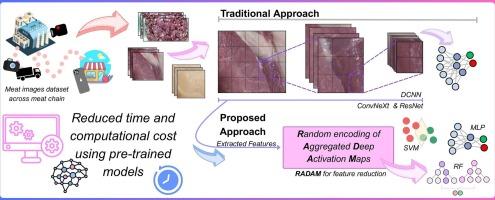Leveraging pre-trained computer vision models for accurate classification of meat freshness
IF 9.8
1区 农林科学
Q1 CHEMISTRY, APPLIED
引用次数: 0
Abstract
Increasing concerns about food quality and safety have led to research into ways to assess meat freshness. Advances in deep learning, particularly image classification, enable up new possibilities for fast and non-destructive methods of evaluating meat properties. This study explored a novel approach for classifying meat freshness based on image data by leveraging features extracted from pre-trained deep convolutional neural networks (DCNNs), followed by random encoding of aggregated deep activation maps (RADAM). The encoded features were subsequently used to train traditional machine learning (ML) classifiers. This approach yielded state-of-the-art results, with classification metrics ranging from 93 to 100 % when classifying beef and chicken meat freshness across three datasets and under multiple hyperparameter settings. Not only does this surpass the performance reported in literature, but it also offers a simpler and more efficient methodology. Findings suggest that the proposed approach could be a practical and effective solution for industry deployment.

利用预训练的计算机视觉模型对肉类新鲜度进行准确分类
人们对食品质量和安全的日益关注,促使人们研究评估肉类新鲜度的方法。深度学习的进步,特别是图像分类,为快速和非破坏性的肉类特性评估方法提供了新的可能性。本研究探索了一种基于图像数据的肉类新鲜度分类新方法,该方法利用从预训练的深度卷积神经网络(DCNNs)中提取的特征,然后对聚合深度激活图(RADAM)进行随机编码。编码特征随后被用于训练传统的机器学习(ML)分类器。这种方法产生了最先进的结果,当在三个数据集和多个超参数设置下对牛肉和鸡肉的新鲜度进行分类时,分类指标范围从93到100 %。这不仅超越了文献报道的性能,而且还提供了一种更简单、更有效的方法。研究结果表明,所提出的方法可能是一个实用和有效的解决方案,为行业部署。
本文章由计算机程序翻译,如有差异,请以英文原文为准。
求助全文
约1分钟内获得全文
求助全文
来源期刊

Food Chemistry
工程技术-食品科技
CiteScore
16.30
自引率
10.20%
发文量
3130
审稿时长
122 days
期刊介绍:
Food Chemistry publishes original research papers dealing with the advancement of the chemistry and biochemistry of foods or the analytical methods/ approach used. All papers should focus on the novelty of the research carried out.
 求助内容:
求助内容: 应助结果提醒方式:
应助结果提醒方式:


